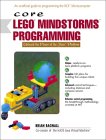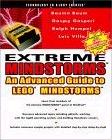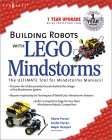Our Book-tips
|

|
As some of you know, Brian Bagnall has been hard at work on a Lego Mindstorms book for Java programmers. The book is titled
Core Lego Mindstorms Programming
and is part of Cay Horstmanns Core series. The official release date is March 15, 2002. This book was edited by Jose Solorzano, who also contributed an interesting section on porting leJOS to other platforms. [info]
NOTE: The leJOS project is using the Amazon Associates program to raise money to obtain
their own domain name.
Here a more detailed comment to the book!
|
Obviously Brian Bagnall is a programming mastermind! His
book gives essential and clear instructions how to install and use the RCX
Java-platform called leJOS. After an introduction to Lego Mindstorms with
unexpected information even for Mindstorms-veterans (Brian solves the greatest
mystery of the Mindstorms kit!), the book leads you through the concepts of
Behaviour Control programming and robot-navigation, which are essential for
advanced mobile robotics. Then you learn about RCX communications and advanced
leJOS topics like Monitoring memory use and Hacking leJOS to save
memory! Finally you find a list of part-providers, utilities and
internet-resources. Every page of this book contains some new and useful
infomation around the Mindstorms-project, which has seen so many books and
internet-sites, that people might think, from now on you only produce
repetitions. For the Core Lego Mindstorms Programming-book this is not
the case, for sure.
The author illustrates his
explanations through images, LEGO-robot building instructions and step-by-step
first-class photos on how to realize a distance sensor and a compass sensor. He
knows the art of clarifying complex things without becoming neither too
scientific nor simply trivial. He respects the assertion that every mathematical
equation will divide the audience by two. But all the reflections are profound
enough for both scholars and non-scholars.
Some words about the compass,
which is the one we developped on this site. Brian honestly reveals the power
and the limitations of an electronic compass. Doing so, he demonstrates well the
force of the leJOS mathematical kernel, which he mostly wrote as contribution to
the leJOS open source project. He shows how the normal mobile robot builder must
deal by software means with reality, unprecision, error-sources, calibration.
This book is a worthy follow-up to the high-level
book-series around extreme Mindstorming and beyond.
Brian, well done !
This brand-new book is a real encyclopedia of LEGO robot
design. The book concentrates on building more or less complex
mobile robot-bases and grabbers. You'll find detailled descriptions, tips,
tricks and constructing strategies with numerous didactical pictures and photos
that may help you design your own solid robots.
The sub-titles are very suggestive :
Discover the undocumented secrets behind the design
of Mindstorms System
The ULTIMATE tool for Mindstorms maniacs
Get inspired by the techniques of world-class
Mindstorms Masters
The authors lead you in an explicit way through the
mathematical and physical problems around robot-positioning, gearing, sensoring
and Lego-geometry without getting lost in dry formulas. They rapidly come to the
point ! As a didactical subtility you find a summary of every chapter and a
chosen collection of the best internet sites related to the theme. The authors
permanently refer to other well-known members of the growing Mindstorms masters
community.
Mario and Giulio Ferrari - the name obliges - are
Lego purists, but still open to expanding the system by original extra-parts
from other sets or service packs, to using unconventional mechanical tricks,
finally to mobilizing creative custom sensors. Ralph Hempel should be
known through PBForth and the book 'Extreme Mindstorms' - which we recommend too
-, where he was the co-author together with Dave Baum, Mike Gasperi and Luis
Villa.
While studying this new book you learn about so various
themes than :
Classic projects like light-follower, walking robots,
robotic animals, good pneumatics, solving a maze, playing chess or pinball,
realizing a simulator of flight, drawing with LOGO, building useful things like
a floor sweeper, participating in robot contests with a Sumo-robot or playing
robot-soccer. You also find the Ferrari SHRIMP.
From our point of view we recognize in this book many of
our own ideas which we developped for over two years now. The authors never hide
the origin where they got their inspiration. What makes this book so interesting
is the fact that it does not represent a passively gathered mix of what others
have done, but an unending collection of improvements, optimizing and
clarifying. So the book becomes a new source of inspiration for all those
who contributed in any way. It surely will support the incredible dynamic of the
Mindstorms-project.
We strongly recommend the book not only to all advanced
Mindstormers but also to newbies who want to learn from masters.
|

|
Extreme
Mindstorms by
Dave Baum, Michael Gasperi, Ralph Hempel
and Luis Villa
editor APRESS |
This should be the standard lecture for all advanced
Mindstormers. Four authors, four book-parts. First Dave Baum gives a solid
introduction to the RCX 2.0 firmware and his famous nqc. He shows the new
features of this second firmware, for example, how to deal with events and
ressource-access, how to use arrays, and so on. Ralph Hempel then presents an
amazing introduction to his replacement operating system pbForth and the
way how to program with it. So does Luis Villa with legOS. The fourth part is
reserved to Michael Gasperi and some of his homebrew RCX-compatible sensors.
The book is highly recommendable for all those who wish to
know more about Mindstorming.
Main Page


